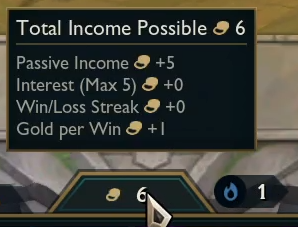How to Play Your First TFT Match
Welcome to our absolute beginner guide for TFT or Teamfight Tactics!
TFT is an “autochess” game that recently celebrated its 6th birthday! As time has passed, more mechanics have been added to the game, making it difficult for new players to pick up.
Learning a new game, let alone a new genre can be overwhelming at times since there is a lot to learn and soak in, but that’s part of the fun! In this absolute beginner’s guide, we’ll teach you the basics so you have a good idea of what’s going on in your very first game.
We’ll assume you have a basic idea of what TFT is and you’re looking to play your first match. If you’ve already played a few and want to learn more we’ll guarantee you’ll learn something new as well.
Let’s learn how to play Teamfight Tactics!
How do you win in Teamfight Tactics?
The ultimate goal of TFT is to be the last player standing in an 8-player free for all match. You spend the game accumulating resources like gold and items and making decisions to build a team of units with different strengths, weaknesses, and abilities.
If you compose your team with units that synergize, they will be empowered with buffed properties. Your team of units will fight against the teams of the other players at random during the rounds. The player whose team loses will take damage. When a player runs out of life, they are out. This may seem hard but getting top 4 counts as a win, so aim for that.
The Start – Encounters
Previously, TFT games would start with a carousel round where you would run to try and grab a starting item and champion. Then from Set 9, the opening Carousel had been changed to Portals, which was a voting system that determined starting bonuses.
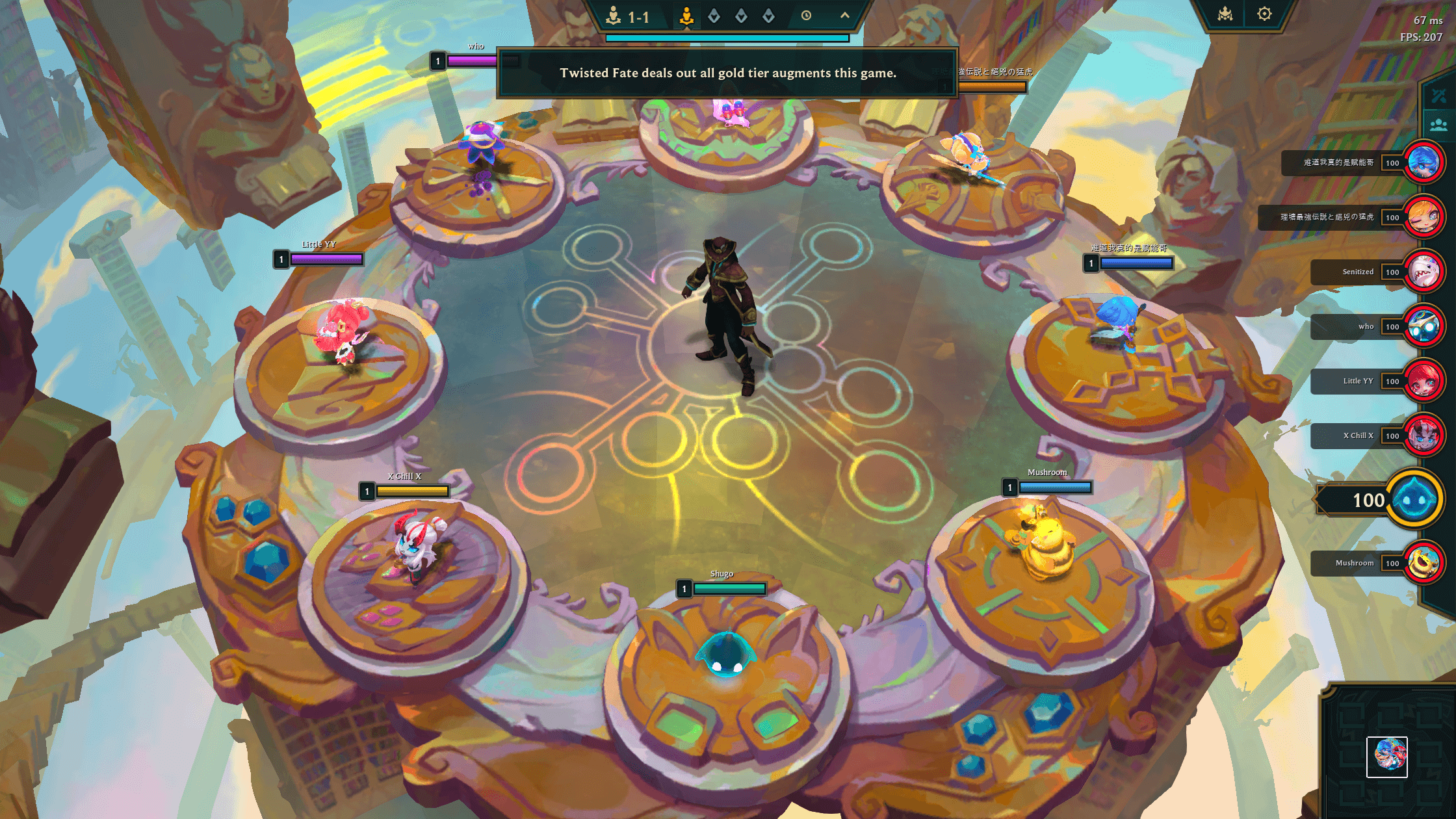
TFT Set 16 Encounter Start
As of Set 13 onwards, Encounters have replaced Portals. Instead of placing a vote, players are now met with a random Encounter, streamlining the overall experience.
Building your First Units: The Three Minion Rounds
Round 1: Placing your unit
Once the game begins, you will be given a random 1-cost Champion, and you’ll ready for your first battle! Don’t worry too much, the first three rounds are against bot-controlled minions that are very easy to slay.
Simply click and drag the unit onto the board in whatever slot you want them in.
To learn more about your unit you can right-click on them during a battle or while they’re on your bench (you can also right-click on the units of your enemies.)
Here you can see your unit’s synergies, health/mana, cost, rank, ability information (by hovering), and items (which you can also hover). Keep these in mind, for now, we’ll discuss them later.
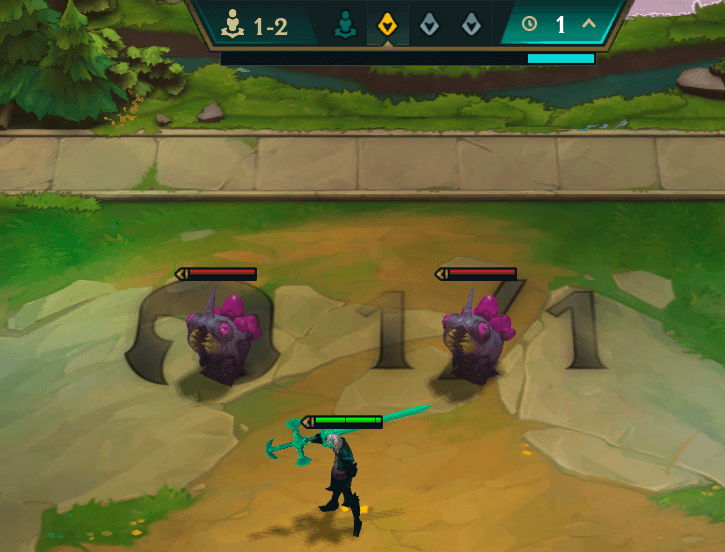
Right-click on any champion unit for more information about them.
To understand what is happening in each round, take a look at the top of your screen. You can see the first carousel round icon, two minion fight icons, and a cube icon. These events will occur from left to right.
Before you fight, you have a set amount of time to prepare (as represented by the countdown). Right now you’ll only be able to change the position of your unit but you’ll have more options in a bit – for now, just drag your first unit from your bench and onto the board. (If you don’t do this, it will automatically be done for you)
Once the countdown finishes, combat will begin and your unit will come alive to fight the minions. Since the minions are weak, your single unit should be able to kill them easily.
Mana and Abilities
While your unit fights, you may notice that their blue mana bar begins to fill up. Your champion will gain mana when they auto attack or take damage.
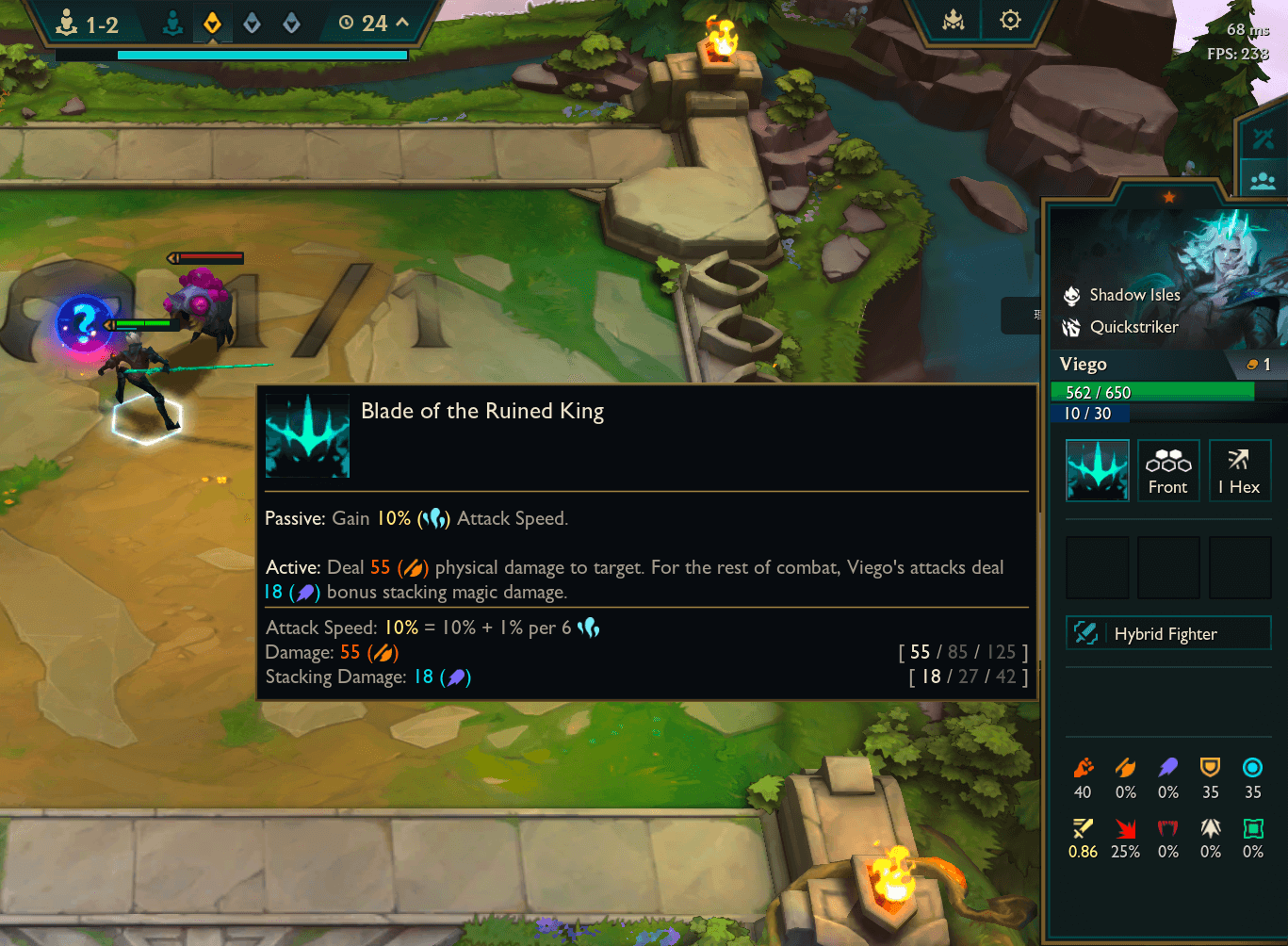
Once their mana bar is full, they will cast their ability. Note that not every champion has an active ability. Some champions may only have a passive or an ability that triggers after specific conditions.
Item Drops
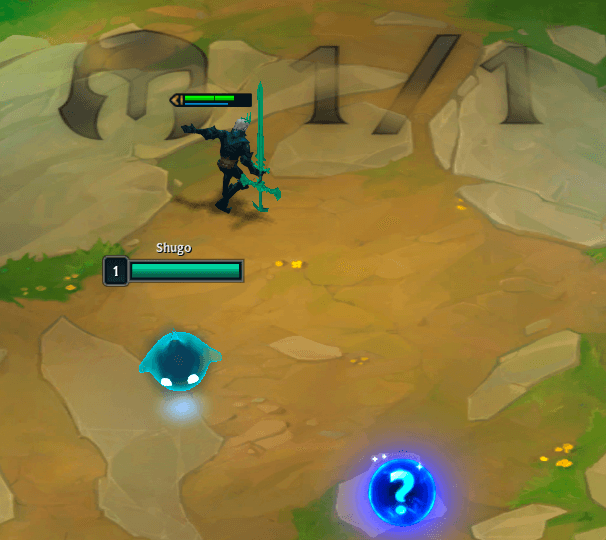
When you fight neutral (PvE) minions and monsters, you have a chance to get loot drops. These drops will give you things such as gold, items, or champions. Item components and other items will accumulate on the left side of your board. Outside of the carousel rounds, this is the only other time you can get items.
Since minion rounds are easy, we don’t need to rush to combine item. Instead, keep it on the bench to keep our options open.
Augments
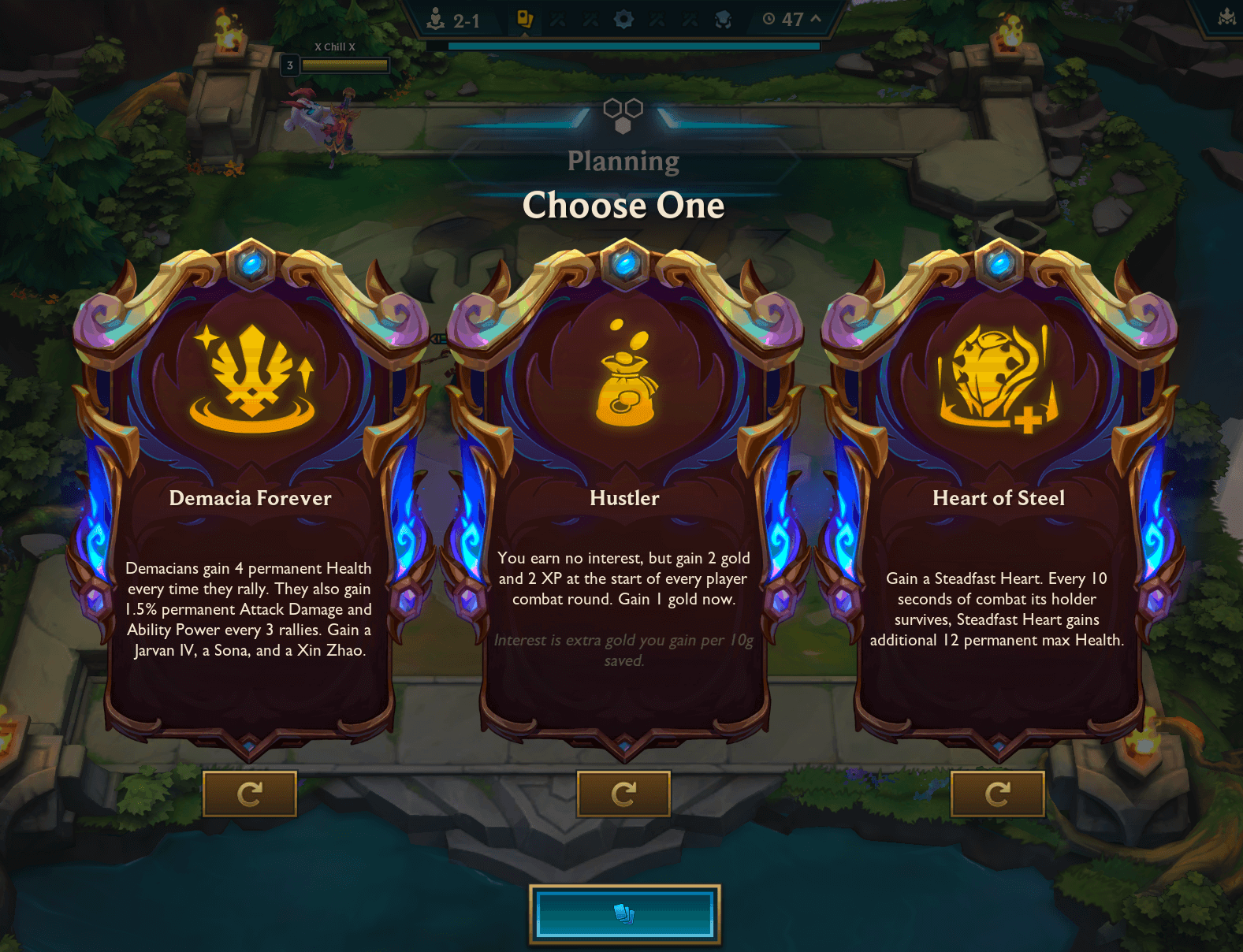
Augments were introduced to the game in Set 6, and have stuck around to today. These grant you bonus effects, whether they may be Gold related or Combat related.
Augments will be offered 3 times throughout the game, at these Rounds:
- 2-1
- 3-2
- 4-2
You can look at each one and select which Augment you want. You’re also given one reroll per slot, meaning you can have up to 6 total Augments to choose from. But when you reroll, you won’t be able to get your old selection back, so be careful.
Rounds 2 and 3: The Shop
After your first minion round, the game starts to really open up in terms of making decisions and constructing your team composition. Let’s take a look at the image below and break it down.

At the beginning of round 2 and every round after until the game ends, you’ll be given five choices of champion units from the shop. All eight players in the match draw from a shared pool of finite pieces.
For each unit, you can see their cost, synergies, and a description of their ability if you hover them.
Above the five units you can see the amount of gold you have. Outside of buying units at the shop, you can also use gold to refresh, or “reroll” to another set of five champions for 2g or buy 4 experience points for 4g. You can also sell the units on your board or bench.
(1 star champions can be returned for their full value but 2 star champions that are 2g to 5g will be refunded for one less gold than their combined amount).
You can also choose to lock your shop (top right corner of the shop) so it doesn’t refresh at the beginning of the next round.
Some quick notes on these options:
- Reroll: If you choose to reroll, your shop will refresh with 5 new units.
- Buy XP: Your player level determines how many pieces you have on the board (if you’re level 3, you can have 3 unit pieces).
- You will passively gain 2 experience each round, but you can spend gold if you’re looking to increase your level and max number of units (up to 9 using experience).
- You can see how many points to hit your next level and your current level at the left of the shop.
- Lock: If you like the options given by a roll but don’t have enough gold to buy everything you need, consider locking your shop so you can buy when you get more gold for your next round.
- Sell: You can sell your units by dragging them onto the shop or by hovering them and pressing E.
With so many options, it can be hard to understand when and why to buy champions. When you first start playing, you should be focused on trying to build toward your unit synergies.
Building Unit Synergies
Building a team around traits is a core gameplay aspect of auto chess games like Teamfight Tactics. There are two types of traits, class and origin, and every champion has at least one of each (some have more). You should be looking to try and pairs units together to activate these trait bonuses.
The left side of your board will showcase what traits are active, and what breakpoints you need to hit to activate these bonuses. As usual, hovering these traits will show what they do and what tiers there are.
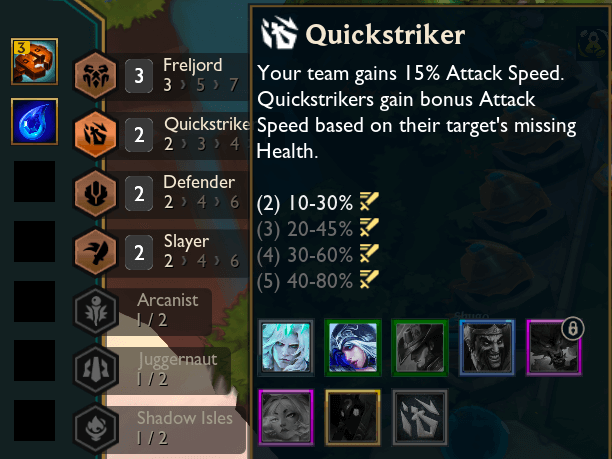
You will see what traits a unit will have in the shop as well. If you remove them from the board, the traits will disappear from the left side of the screen.
There are a ton of really cool synergies in TFT to learn more about them and their unique abilities, be sure to check out our wiki’s on origins and classes.
The way you learn about team comps depends on who you are as a player. If you’re someone who likes to learn on your own, feel free to experiment and learn through trial and error about which classes and origins work together well.
If you’re someone who wants to win now or immediately learn what’s good, check out our team comp recommendation guides to see team comp builds refined and tested by high-level players.
Starring Up Units
Another core mechanic to keep in mind is that in TFT, you can combine identical units in order to make stronger ones – this is called starring up (also called leveling/ranking up).
You can rank up your units by combining three copies for each tier:
- Three 1 star units = One 2 star unit
- Three 2 star units = One 3 star unit
- This means that you need a total of nine 1 star units to get a 3 star unit.
- Units you buy from the shop are 1 star
In the image below we have two copies of the same unit, one on-board, one on the bench. The shop then presents the third copy, who will be highlighted to clearly show that purchasing will combine all three into a 2-star.
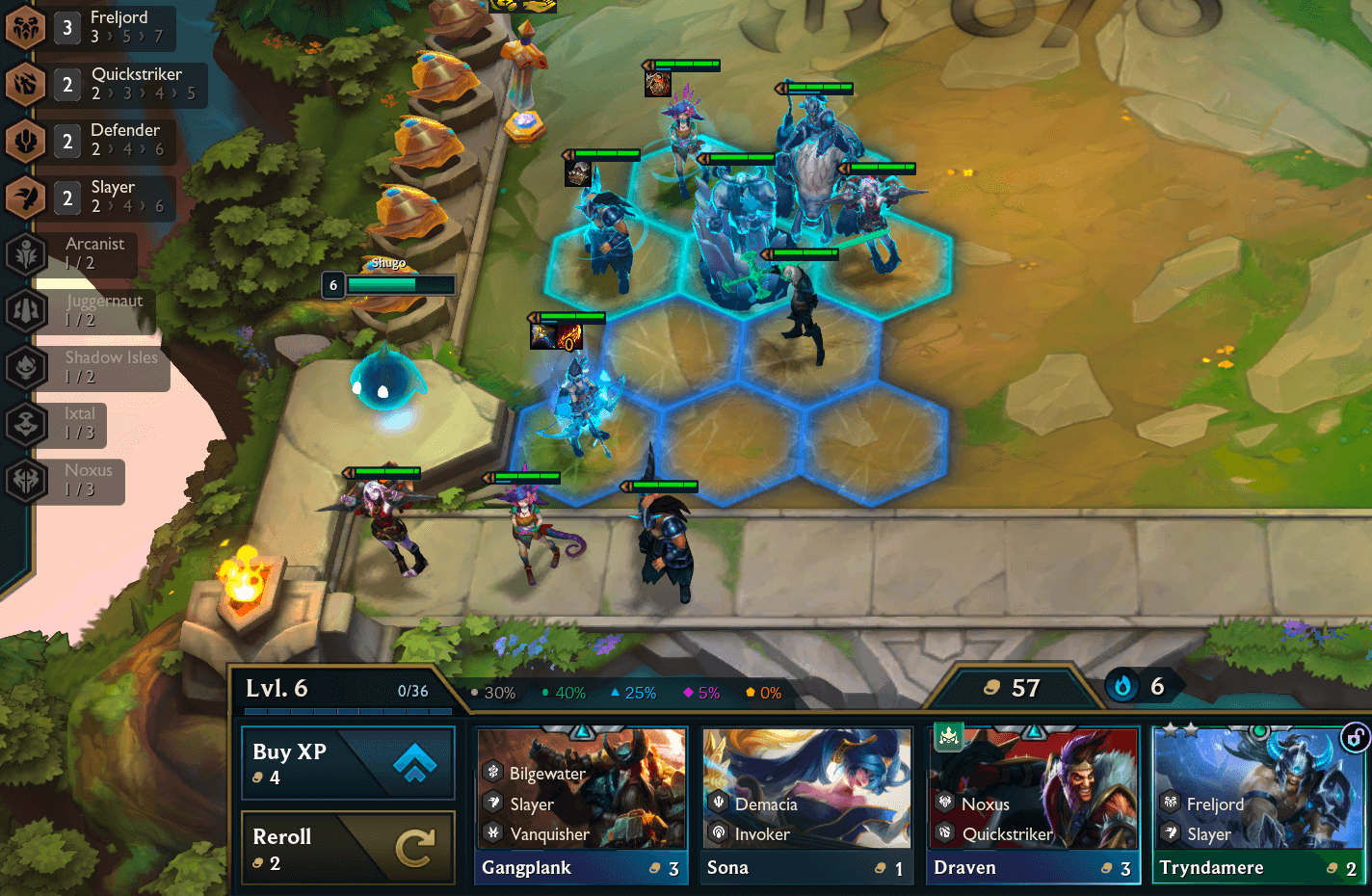
When this transformation occurs, the champion grows in size and in power. The rank up will also alert everyone in the game in the chat log, so know that it’ll draw attention and keep an eye on the activity of other players.
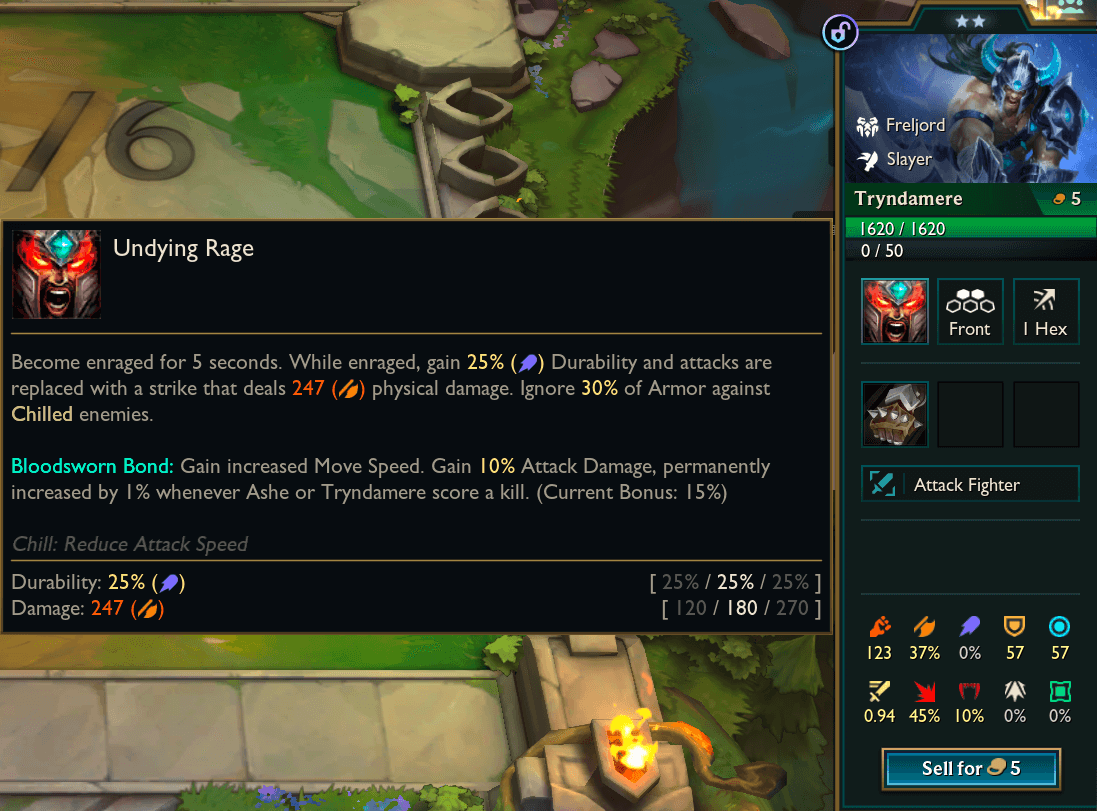
When a Champion stars up, their Ability will get stronger, and their Health, AD (Attack Damage), and AP (Ability Power) will increase. Notably, the Armor, MR, Attack Speed, and Crit stats of champions do not increase when starring up.
Shop Odds

As you level up, the pool of champions available to you and their probability of appearing changes. Right above the shop to the left of your gold is an indicator showing the odds of finding an x-cost unit. From the image above, we see that currently at level 4, there is a 55% chance of 1-cost, 30% chance of 2-cost, and 15% chance of 3-cost.
As you level up, the odds will shift to the right, letting you find more powerful champions.
Now that we know the basics of team building and which units to target, let’s get back to the game walkthrough.
TFT Set 16 Mechanic: Unlockables
Unlockables is the new Set Mechanic, allowing for a grand total of 100 unique champions to exist in the game. While 60 units can be found normally, the other 40 must be unlocked. Each Unlockable comes with its own requirement, opening the door to several branching pathways to explore.

For a deeper dive into how Unlockables work, check out our TFT Set 16 Unlockables guide.
Round 2-1 and Onwards: PvP Until Last Player Standing

After the three minion rounds end, Round 2-1 will begin and you’ll start to have player vs player fights. The image of cards displays an Augment selection, and you will still fight a player in this round.
The 4th round will be a carousel, where players pick a free champion + item. Finally the Stage ends with a neutral round, where you fight more minions/monsters for loot drops.
This pattern will repeat until the end of the match when one player is standing (top 4 counts as a win). In the following sections, we’ll be discussing the overall concepts of a match instead of walking you through round by round.
PvP Rounds
During the PvP rounds, you’ll face a random opponent and pit your team of champions against theirs.
Depending on how badly the winning side wins, the losing side will take damage. There’s a specific formula for this but since this is a beginner’s guide, to simplify it, just think about it in terms of units that survive on the winning side.
If you have a really close battle that ends in a 1v1 between two final units, the losing side will take a small amount of damage. If the winning side wins by a landslide and has many surviving units, the loser will take a large amount of damage.
In the image above, you can see the standings based on how much health players have. By clicking on their icon, you can also take a look at their board and bench.
You can also do this by clicking on the minimap at the bottom right, or by using the 1, 2, and 3 keys to rotate between player boards or return to your own (1 and 3 cycle, 2 returns you back home).
Carousel
As we mentioned earlier, the 4th round of each Stage will include a carousel. Player standings are important because it determines the order in which players choose their pieces at the next carousel phase.
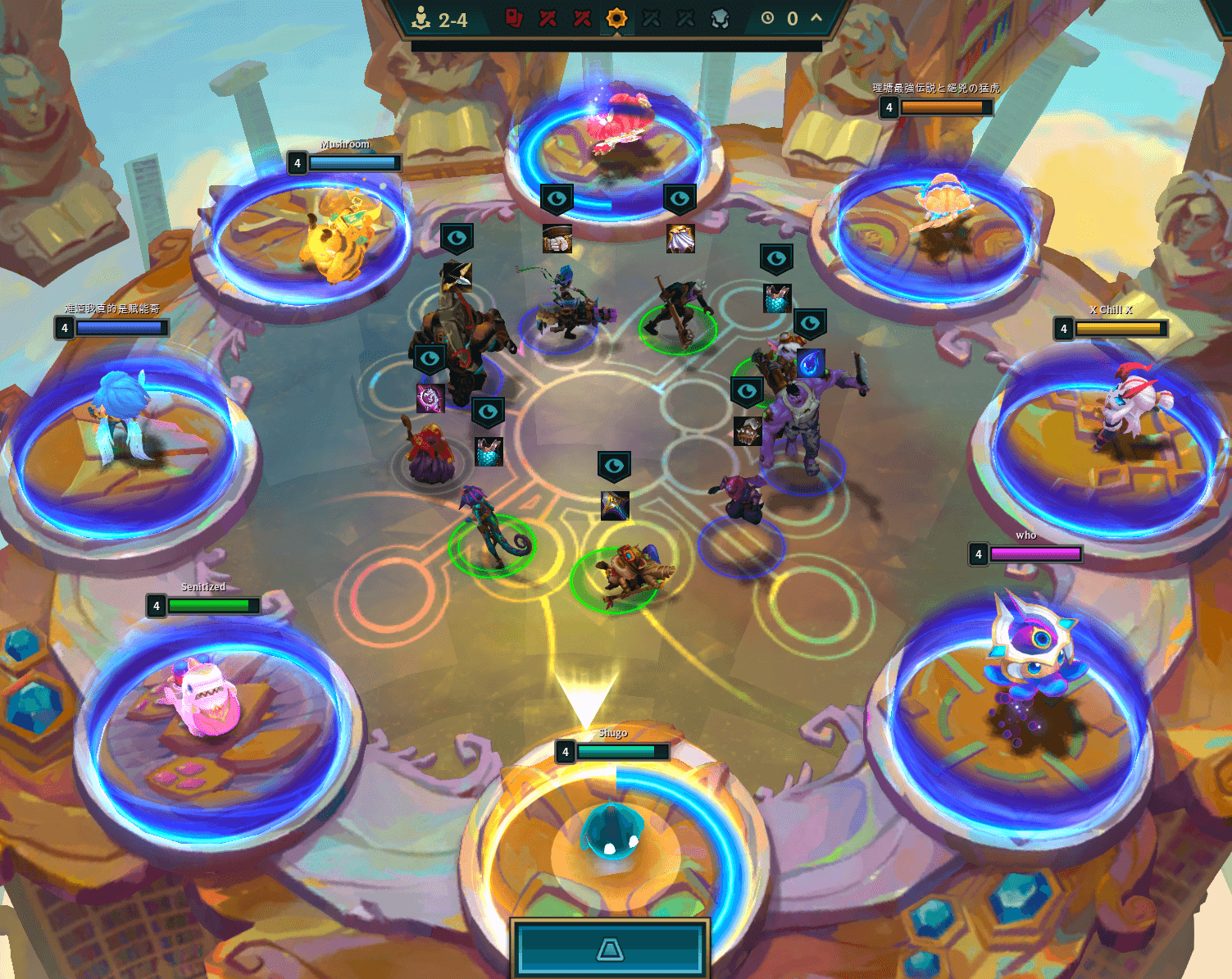
All players begin the carousel phase locked and are released 2 at a time in reverse order starting with 7th/8th and ending with 1st/2nd. This lets players who have fallen behind an opportunity to catch up since they are more likely to get the item and unit that they need most.
At this point, you may be asking, if players that are doing worse get better choices at carousel rounds, what’s the point of being ahead? Well, I’m glad you asked.
The Basics of Econ: Win Streaks, Lose Streaks, and Interest
In Teamfight Tactics, you’ll get passive income for free each round. The first few rounds, you’ll gain increasing gold every round starting from 2 gold up until a base of 5 gold per round. You get 2g round 2, 3g round 3, 4g round 4, and 5g round 5 and every round after.
You also get additional gold based on win/loss streaks and interest. If you are winning or losing consecutively, you will gain extra gold – here’s how it works:
- 2-4 round streak = 1 extra gold per round
- 5 round streak = 2 extra gold per round
- 6+ round streak = 3 extra gold per round
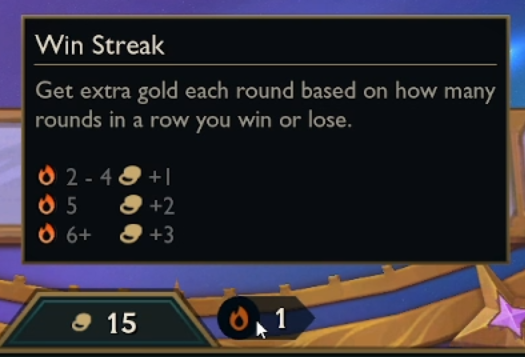
This rewards players who have been doing well and throws some love to players who are having a rough time (there’s actually an advanced playstyle where you lose on purpose to get lose streak income and a good place in line for carousels, but that’s not for this article). You also get +1 gold if you win a PvP round.
Depending on how much gold you have at the end of a round, you also get an interest bonus at the beginning of your next round. The amount of interest you get is related to every 10 gold you have up until 50:
- 10g = +1g interest
- 20g = +2g interest
- 30g = +3g interest
- 40g = +4g interest
- 50g = +5g interest (the max)
- Example: If you end the round with 34g, you will have an additional +3g from interest next round.
You can check how much gold you’re earning per round at any time by hovering your gold in shop.
To learn more, we strongly recommend checking out our TFT economy guide. We’ll cover these topics in more depth and give fundamental strategies regarding gold and econ management.
Positioning Basics
Managing your economy, buying units, and assembling your team are incredibly important but can all go to waste if you don’t position your units properly.
Making sure that your units are in the most optimal places possible will help you get the most value out of them and increase the consistency of their success in battle.
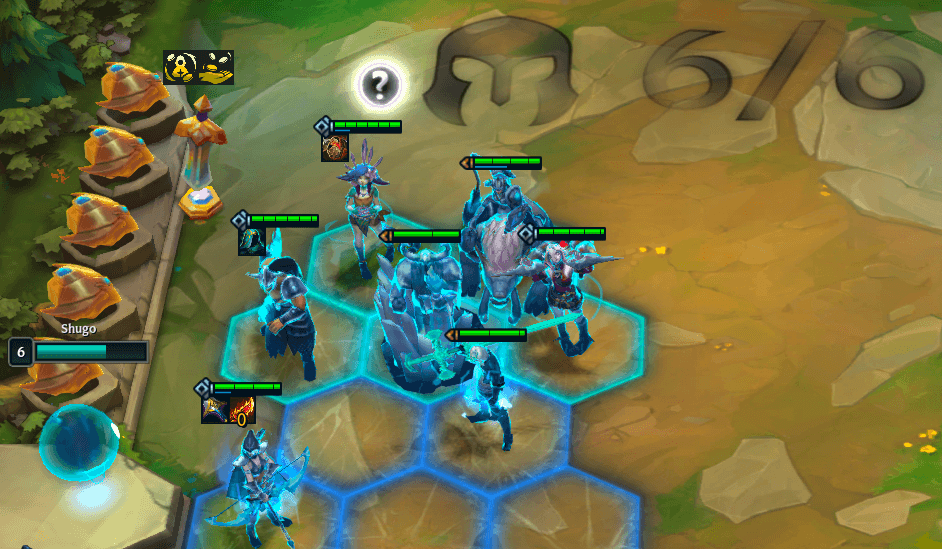
You can always reference the champion’s hex range and recommended positioning by inspecting them.
Here are general guidelines:
- Since mana is generated from fighting and taking damage, you want your pieces in a position where they are actively dealing damage and taking damage to cast their abilities (without dying of course).
- Try to have your units cast their ability at least once. If they’re dying before that, something is likely wrong.
- Most team compositions are similar to League, you’ll have a beefy frontline that protects your squishy backline of damage dealers and utility units.
- As the game goes on and you have a better idea of who you’ll be facing (since there are less players in the game), you’ll want to adjust your positioning accordingly.
- To save time, you can swap units by dragging one unit onto another. They will automatically switch places whether they’re on the board or the bench.
To help these make more sense, we’ll cover the main fundamentals of positioning.
Frontline and Backline
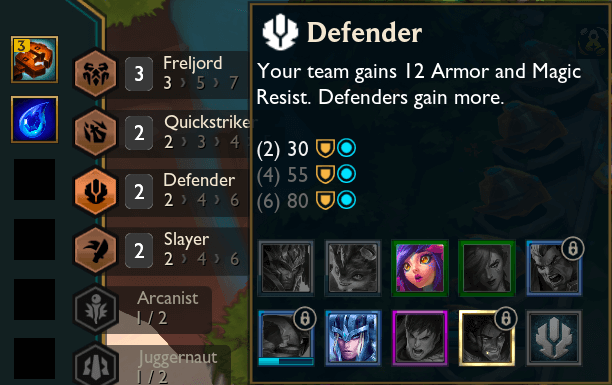
At the very basic level, you should position your units with a simple idea of frontline and backline.
Frontline Units: Frontline units usually have a defensive trait like Bruiser or Defender that lets them absorb damage from enemy teams. These units will usually be melee units as well, so placing them in the front ensures that they won’t need to spend time walking up to hit enemies.
Backline Units: Backline units are simply the opposite. Backline units usually either provide damage or utility abilities like healing and shields. These units usually have range that allows them to hit enemy frontline units without needing to move as much.
Without getting too specific, almost all comps follow this general idea. You can do other things like place more toward the right or left side, or even in the middle of the board. Some synergies also make it so you want to place your units close together or further apart.
To learn more about how to place your units and the fundamental concepts for doing so, check out our TFT positioning guide.
How to Combine Items and Who to Give Them To
Throughout the article, we’ve mentioned that you could get items from the carousel or monster rounds but we haven’t really covered what they’re for and how to use them. In this section, we’ll finally discuss how to best use them and why you should prioritize certain items over others – here are the main things you need to know:
- Every unit can hold a maximum of three items.
- Granting a unit an item is permanent. In order to move an item to another unit, you’ll have to sell the unit currently holding the item or use a one time use item remover.
- There are two types of items, basic components and combined. Giving a unit two basic components will create a combined item.
- In general, you’ll want to use items to augment the strengths of your team comp.
Items do everything from granting basic stats like health and attack speed to breaking the game by letting you exceed the max number of units. Having the right items on the right units will strongly increase your chances of winning, especially against teams that don’t use their items as well.
Example #1: Guinsoo’s Rageblade (empowering auto-attackers)

Guinsoo’s Rageblade grants its wearer 6% additional attack speed every time they attack, and it stacks infinitely. This means that they’ll attack faster and faster the longer a battle goes.
This is good for units that deal solid damage with their auto attacks. It can also be a strong item for AD units with strong abilities as faster attacks leads to faster mana generation.
Example#2: Spear of Shojin (cast abilities more often)

If it wasn’t apparent by now, abilities are game-changers in TFT. As we mentioned in the positioning section, getting one ultimate off is usually seen as a success. Spear of Shojin allows its wielder to cast their ability more often because they gain 5 mana per attack.
This is insane on champions that have really powerful ultimates. Late in the game, you will often have a powerful backline champion cast multiple times throughout the fight with Spear of Shojin or other mana generating items.
Item Tier List and Recommendations for Every Champion
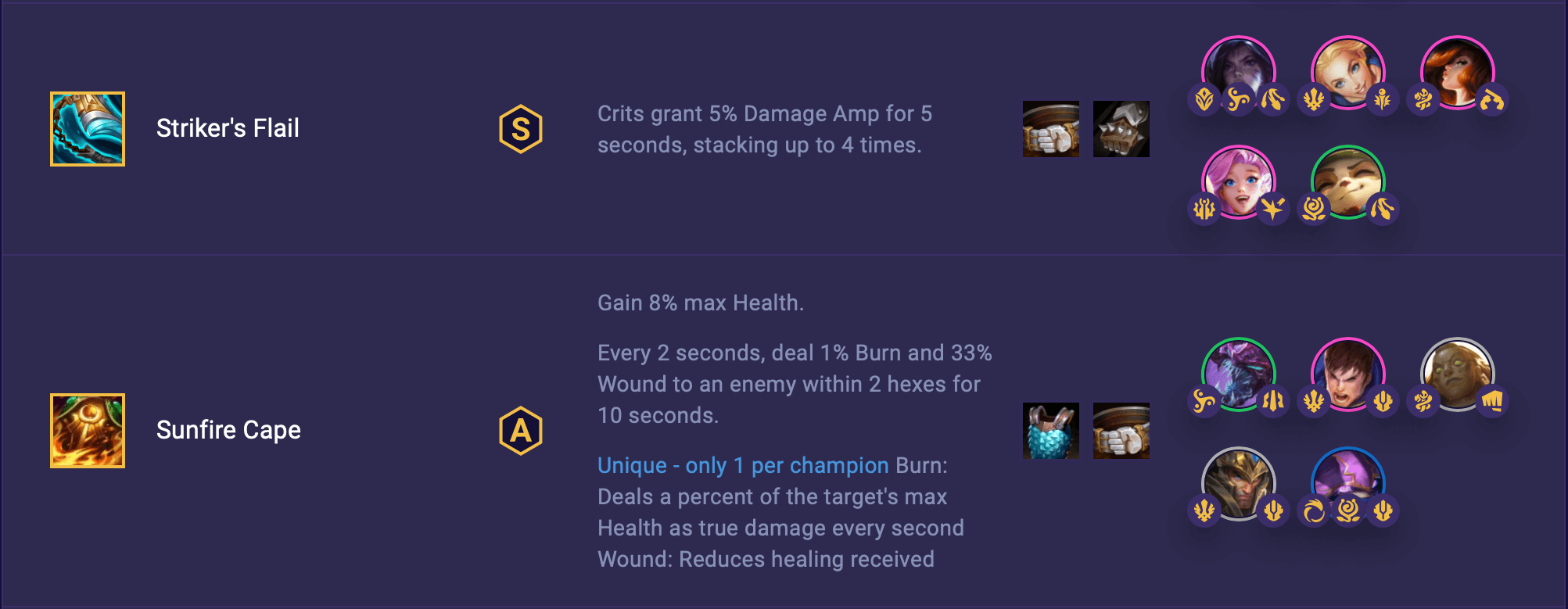
Items are one of the trickiest aspects of TFT to get the hang of. Since you’re just starting out, it’s a good idea to try them all out to see how they feel and work. To make the process easier, however, we strongly recommend checking out our TFT items tool.
We not only give you all the recipes for combined items, but we also tell you which champions each item is best for and rank them according to their tier. By following our recommendations there, we guarantee you’ll learn at a faster rate and see your success increase in your matches.
Frequently Asked Questions by Beginners
Lastly, we want to try to answer some questions we see often from beginners. As a disclaimer, know that Teamfight Tactics is a very situational game so we will do our best to give the most accurate answers possible, but things may be different for you based on the context and skill level of players in your matches.
If we didn’t cover your question in this Teamfight Tactics guide, let us know in the comments!
Should I spend gold early and try to see which units I can get the most of or should I save?
Definitely check out the guide we linked in the economy section above. We cover three main strategies that will help you with the decision making process related to spending to find upgrades or saving up.
In general, if you’re looking to maintain a win streak, it may be more worth it to look for upgrades to continue to snowball. Keep in mind, however, how realistic your odds are.
If you aren’t winning early on, it’s probably more beneficial to save up, as long as you aren’t getting completely destroyed and losing tons of HP. If you’re able to get a lose streak while staying healthy, you’ll be in a position to not only max interest but also be in a good spot at carousel rounds.
Which champions are strong when?
This is leaning towards a more advanced concept called “power spikes”, which if you’re a League player, you may be familiar with.
In a nutshell, it means that most pieces have a point in time where they are designed to be strongest, and times where they’re expected to not be good or fall off.
In general, attack speed is better early game, and raw burst is better later game. Single target abilities are better early game, AoE abilities are better late game.
Should I give my tanks items or my back line?
It’s good to have a mix of both tank items and damage items. Most team comps will have a strongest damage carry and tank unit. By having 3 items on each, you’re maximizing your item potential.
As you get more champions and items, you can continue spreading them based on what you need.
Where do I position my units? Why do some people have all their units on the left side, others on the right, and others in the middle?
Positioning your own units depends on your team comp and the units you have, be sure to follow the guidelines we gave in the positioning section above.
In regards to other players, they are in different places because they are trying to find the ideal placements for their team against the rest of the competition.
Sometimes little tweaks here and there make a difference, and as the games wind down and the number of players decreases, positioning becomes even more important.
Should I hold onto my items or use them ASAP?
In a nutshell, you want to try to get the ideal items on your ideal champions. If it’s the early to mid game and you still have time to find these, it may be better to hold on and wait instead of combining for weaker items.
However, you still want to build some items so you aren’t weak compared to everyone else. There are a lot of items that are strong in a variety of team comps, making them safe to build early. Tank items are a great example of this.
Remember that item combinations are permanent and there’s no way to get an item back without selling the unit holding it or using an item remover. Another good tip is to use a 1 cost unit to create a combined item on and then sell it, that way you don’t have to worry about accidentally combining with a basic item that your carry was holding onto.
To learn about the latest new TFT Set, head to our all-in-one Teamfight Tactics Set 16 reveal page that covers all champions, synergies, and more!
Subscribe to our newsletter:
Don’t miss out on all of the latest TFT content!
 Download APP
Download APP Collapse
Collapse

